"Counterattack" and more: Ukraine will receive bridge layers for heavy Western tanks
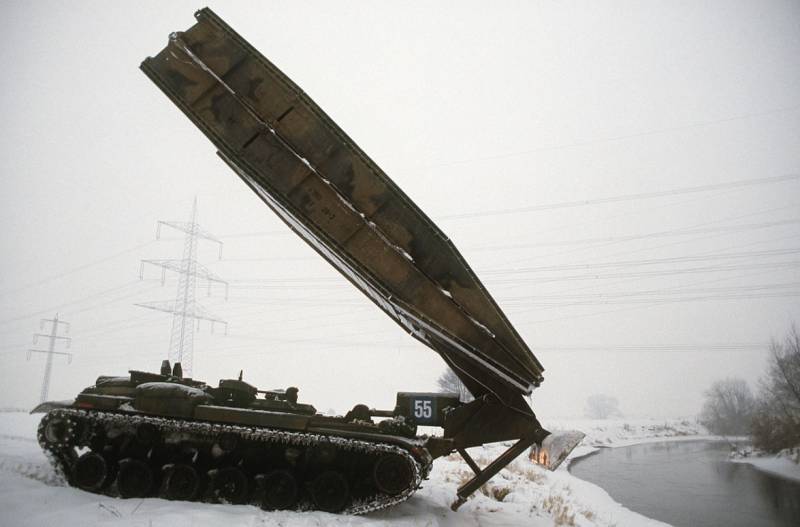
Just the other day, the US Department of Defense announced a new $400 million military aid package for Ukraine. In addition to ammunition for various artillery systems, spare parts and various types of equipment, it will also include bridge layers based on old American tanks M60. But, as they say, the old horse does not spoil the furrow.
To date, the M60 AVLB is actually the only engineering vehicle of this kind for the Ukrainian armed forces, which, without any problems, can organize the crossing of absolutely any Western-style tank, from the light Leopards-1 to the heavyweights represented by the Challenger-2, " Leopard-2 "and in which case even the latest modifications of the" Abrams ". Although there are many more problems that the American bridge layer can solve.
Bridge on a tank chassis - why is it needed?
In general, the subject of engineering equipment in the zone of a special military operation in Ukraine has almost never risen above the level of a couple of mentions in the media for all the time. Against the backdrop of this “calm”, the sudden boom in connection with the transfer of American M60 AVLB bridge layers to the Armed Forces of Ukraine even causes some surprise - they finally remembered that tanks do not fly through the air and sometimes require servants from engineering units.
In this regard, I would like to recall a little about why these bridge layers are needed at all and why they are carried out on a tank chassis.
In short, on the way of combat units, especially if we are talking about the advanced in the face of motorized rifle and tank ones, there are not always exceptionally smooth asphalt or dirt roads, which are a pleasure to drive on. Steep ravines, wide streams with vile weak soil at the bottom, rivers and other features of the local landscape often come across. And you should not forget about the activities of the enemy - the same anti-tank ditches, trenches and broken spans of bridges do not lose their relevance in our time.
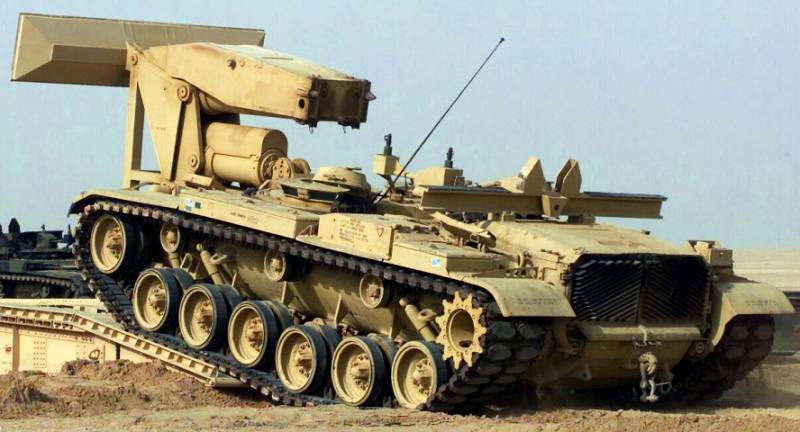
The bridge layer, made on the basis of the M60A2, enters its own bridge
In general, all those obstacles that military equipment is not able to overcome on their own are eliminated by a bridge layer, which opens and installs a bridge through them for free passage. True, up to a certain limit - bridges are strictly limited in length.
However, it is worth noting that these self-propelled bridges are used in a variety of situations: in the offensive, in defense, and on marches, and so on. And the crossings they have established are used not only by armored vehicles, but in general by everyone who needs these crossings. That is, in fact, this is an indispensable technical tool for any army that performs slightly more functions than just one decorative one.
On the basis of the tank, bridgelayers are created for two main reasons.
Firstly, in fact, simple unification - in most components and assemblies, as well as in repair kits and other accessories, the tank bridge layer is identical to the tanks used in the troops. It's cheap and easy to operate.
Secondly, tank armor. It allows the bridgelayer to operate dangerously close to the enemy and be in the first combat formations. Largely due to such properties, this technique - mainly in the West - is called assault bridges. If we are talking about our troops, then tank bridge layers, along with IMR and BREM, are part of the triad of front-line engineering vehicles.
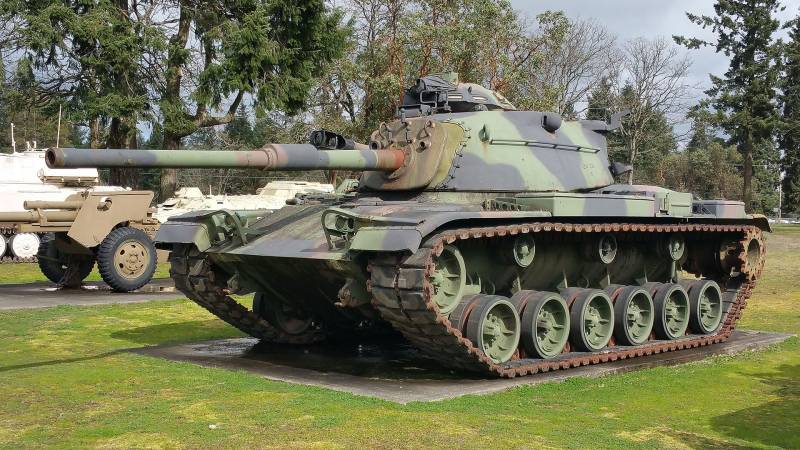
Tank M60, which served as the base for the bridgelayer
But, in addition to the length of the induced crossing, bridges have another significant limitation, which is the mass of the object passing through it. Neither we nor the armed forces of Ukraine - and we use the common Soviet legacy - simply do not have bridge layers that can organize the transfer of Western tanks, whose combat weight is much more than 60 tons. But these heavyweights will someday appear in abundance, so the problem of the lack of mobile bridges with the required carrying capacity is especially acute for the Ukrainian troops.
Moreover, the likelihood of an offensive by the Armed Forces of Ukraine and, accordingly, an assault on the fortified areas of the Armed Forces of the Russian Federation has long passed from the category of "possibly" to "it will definitely happen."
Although no one is saying that the M60 AVLB will only be used for Western tanks.
"Old Man" M60 AVLB will still give heat
It is important to note here that Ukraine will also get bridge layers based on the Leopard-1 tank called Biber. The carrying capacity of its bridge is not as high as our opponents would like - it is unlikely to handle more than 55 tons. However, the Armed Forces of Ukraine have a whole mountain of lighter equipment that a German product can serve: Soviet-style tanks, infantry fighting vehicles and armored personnel carriers of Soviet and Western models, and so on. The hero of today's material can also be used, but more on that later.
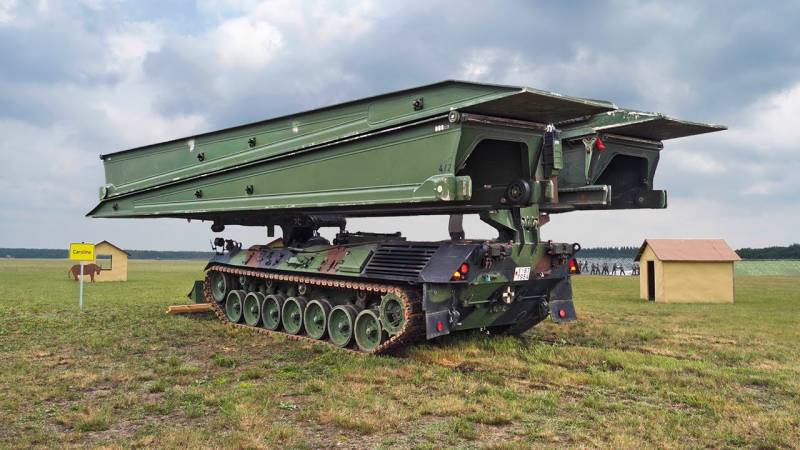
Biber bridge layer on Leopard 1 chassis. One of its advantages is that when installing the bridge, it does not raise it vertically, and this has a positive effect on camouflage.
In general, they will not remain idle, you should not smile. Especially against the background of the almost complete absence of other bridgelayers from the Ukrainian military. The same The Military Balance 2022 gives - according to official lists - a certain number of MTU-20s that are not the best in operation. Although Kyiv has other copies “out of the list”.
But, whatever one may say, the M60 AVLB stands out from its colleagues here.
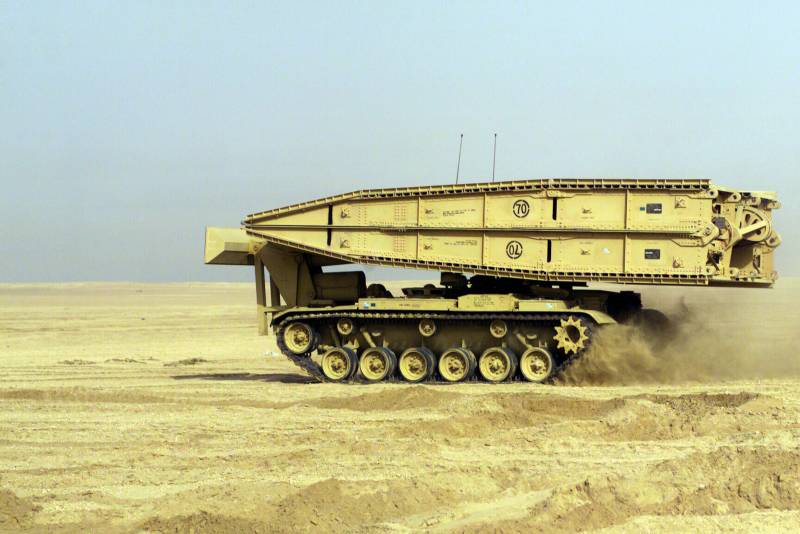
To some extent, the title of “old man” of the engineering service is quite applicable to this bridge layer simply because it was developed and put into service long before the appearance of most samples of Western armored vehicles, which are now planned to be transferred to Ukrainian troops.
Production of the M60 AVLB bridgelayer began in 1964. Moreover, the release of the new AVLB takes place in two peculiar waves: the first lasted from 1964 to 1967, during which the M60 tanks and its modifications M60A1 were used as a base. Then, after a long period, due to the increased military needs of the United States, production was resumed in 1987 and lasted until 1996, during which the lion's share of the vehicles was assembled on the chassis of already used M60A2 tanks.
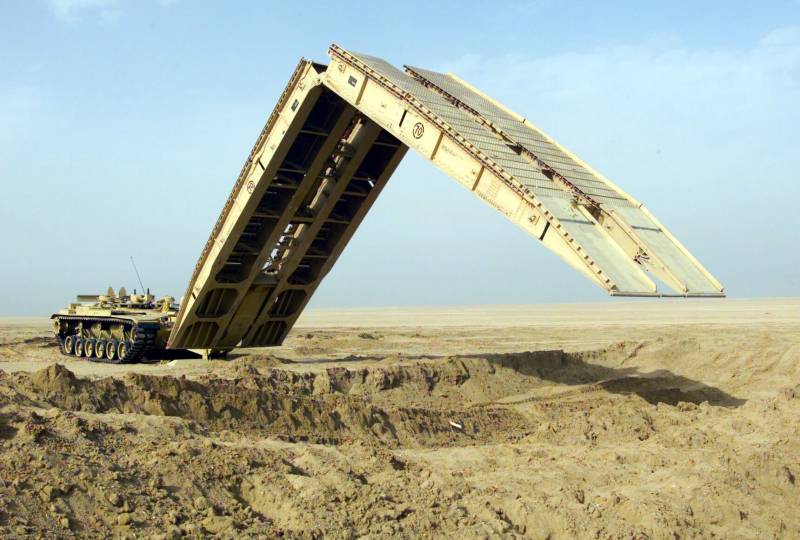
In total, about 400 bridge layers were produced. For 2022, the US had about 260 M60 AVLBs - 30 of them in the Marine Corps. Although now they are being replaced by M104 and M1074 engineering vehicles based on the Abrams tank.
By design, the bridge carrier is a heavily redesigned chassis of the M60 tank and its modifications in terms of internal and external equipment. Although, however, there is nothing radical that could single out this particular instance from the entire family of engineering equipment of this class.
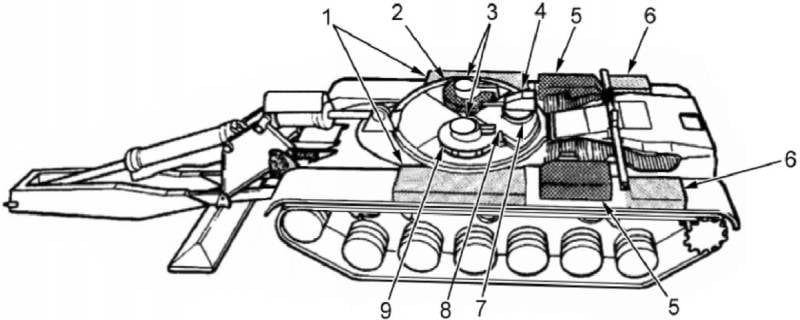
1 - storage boxes in the front fenders; 2 - commander's cupola; 3 - hatches; 4 - antenna mount; 5 - engine air cleaners; 6 - storage boxes on the rear wing; 7 – fan cover; 8 - hydraulic oil reservoir; 9 - turret driver-operator
For obvious reasons, the vehicle does not have a tank turret: instead, hatches and turrets with viewing devices for the entire crew of two people were installed: the commander, located on the right, and the driver-operator (driver) on the left. There is also a reservoir for hydraulic fluid and an armored cap for the ventilation system.
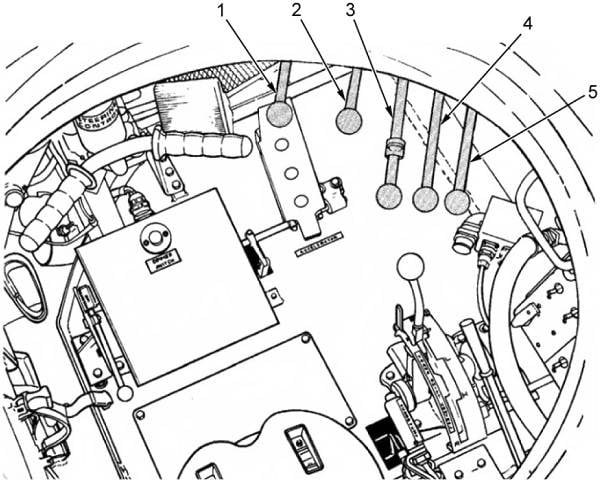
Schematic representation of the driver-operator position of the M60 AVLB. The numbers indicate the control levers of bridge laying mechanisms
Inside the place of the commander is equipped with means of communication and surveillance. But the driver-operator has a whole arsenal: his functions include both controlling the movement of the bridge layer, and the installation or lifting of the bridge itself. Therefore, in front of him is a steering wheel, pedals and other attributes for driving, but on the right is a set of levers for manipulating the bridge.
In the bow of the M60 AVLB, where the driver was previously located in the tank version, there is a hydraulic system with power take-off from the main engine, which, using a lifting device on the frontal armor, raises and unfolds the bridge, or lifts it from the ground and folds it if the passage of vehicles finished. It is worth noting that these manipulations can be carried out without the crew members going outside, although in most cases the vehicle commander observes and controls the process from the outside.
Full specifications can be found here here.
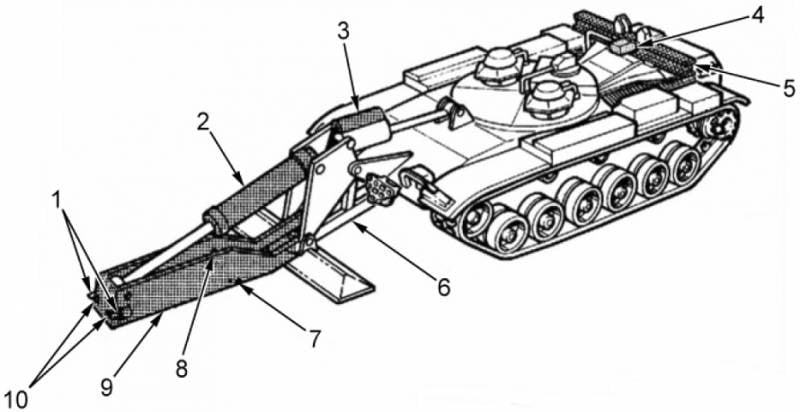
1 - pins; 2, 3, 4, 8, 10 - slave cylinders; 5 - stern support of the bridge in the folded state; 6 - outrigger; 7 - guide pin; 9 - mounting part of the lifting device
The bridge itself is made of aluminum alloys and consists of two folding sections, providing the length of the crossing in the unfolded state within 18 meters. In principle, this indicator is still considered quite satisfactory, especially when it comes to the load that this bridge is able to withstand.
Until the 90s, M60 AVLB axles were limited to 60 "short" tons, which equated to about 54 metric tons. That is, without any problems, both the M60 and M1 Abrams tanks could ride on them. However, due to a sharp increase in the mass of the latter, and they began to get fat very significantly from modification to modification, new reinforced bridge structures were introduced.
So, at first, the standard for the carrying capacity of bridges was increased to 70 “short” tons, which in terms of 63 metric tons, traditional for us. Then, more than ten years ago, the M60 AVLB began to install bridges for 85 "short" tons - 77 tons metric. So not only the heaviest "Abrams" of the latest modification will pass through them, but also some kind of "Merkava" Mk. 4 will slip, not swear. Although I had to sacrifice the width of the barrier, which was reduced by 3 meters.
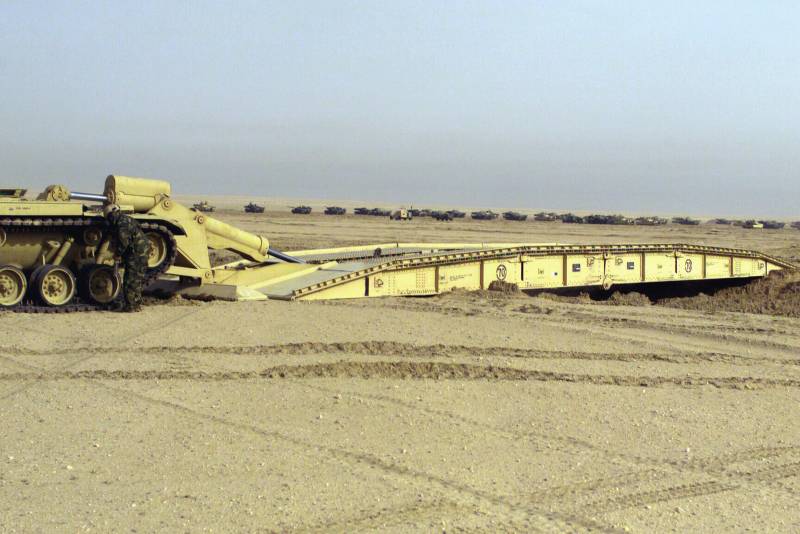
Based on the fact that bridge layers with a carrying capacity of 70 and 85 "short" tons are now the main ones in the United States, it is not difficult to guess that they, or one of these options, will be sent to Ukraine. There is no big difference here: both bridges will make it possible to organize a crossing for any of the Western tanks planned for transfer - both the Challenger 2 and the Leopard 2.
Good for a lot
The transfer of M60 AVLB bridgelayers to Kyiv can actually be viewed from different aspects that do not contradict each other.
On the one hand, Ukraine is already scratching its hands in anticipation of the use of Western tanks, for the mass indicators of which nothing from the Soviet engineering equipment was designed at all in terms of establishing fast crossings on the battlefield. Perhaps banal, but “self-propelled bridges” are simply a necessary addition to the set of equipment that the Armed Forces will receive. Even though tank deliveries are calculated at a dosage of “a teaspoon per hour”, it may someday turn out that they will not be able to overcome the gifts from our zemplekops and the insidious features of the landscape without help.
On the other hand, and most likely, the supply of both the German Biber and the American M60 AFLB pursue a more prosaic and ordinary goal: to fill the shortage of bridgelayers in the Ukrainian troops before the upcoming offensive.
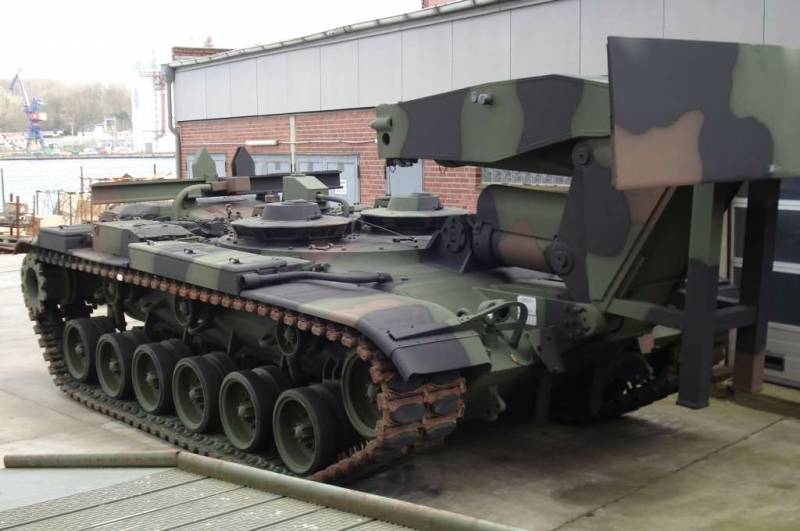
Bridge-layer chassis without bridge
Still, you need to understand that the terrain in the war zone in Ukraine is not very favorable in itself, and it's not just about the chernozem trough, in which both tanks and trucks are drowning. It is full of natural ravines, rivers and other things that impede progress. And if we add to this fortified areas, pitted with trenches and ditches? By the way, it is the fortification component in this situation that is one of the main factors determining the need for engineering equipment.
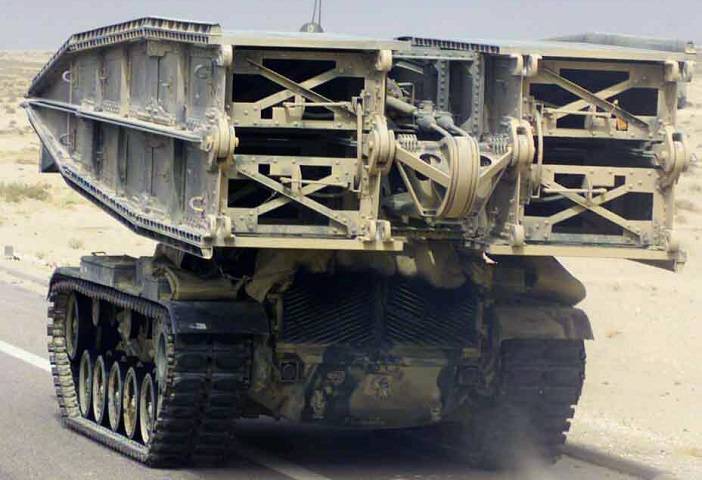
One way or another, the almost complete absence of front-line bridgelayers will affect not only the patency of the Leopards and Challengers, which are not expected to be many in the short term, but the advancement of completely Soviet tanks, assorted infantry fighting vehicles, armored personnel carriers and other vehicles of Soviet and Western types , which in the future will still continue to constitute the main striking power of the Ukrainian army during the offensive. So the gift in the form of the M60 AVLB, and Biber too, in terms of the degree of usefulness for the Armed Forces of Ukraine, is not very inferior to that of the tanks transferred and planned for transfer.
Information